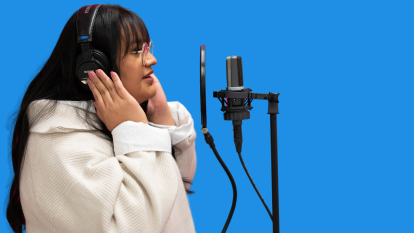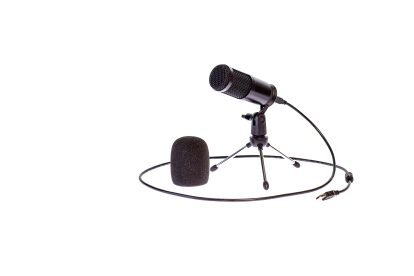 Auditioning
Auditioning
5 Ways to Improve Your Voice Acting Auditions
Are you getting the most out of the auditions you do?
What if you could put 5 tips into practice that dramatically impact your ability to capitalize on the available voice acting auditions?
The Psychology Behind Custom Auditions
In an audition situation, talent who submit custom demos are usually rewarded with extra attention and regard from the client receiving the auditions.
While this may seem obvious, the psychology behind the submission and reception of custom demos is highly overlooked.
On the voice talent side of the equation, the goal is to present the client with something that best reflects the project requirements while demonstrating his or her vocal abilities in a practical manner.
Recording the custom demo also gives a talent the option to include that significant tidbit of information in their written proposal, catching the eye of the client and raising interest levels in their submission.
That being said, when clients receive custom demos, they usually give them more weight than a stock demo submission, especially if they are presenting the demos to their own clientele.
From the clients point of view, a talent who submits a custom demo is more keen to work for their company. Considering their interest level and the time they invested to record a custom demo, the client may also perceive the talent as more qualified to work for them.
Though custom demos are regarded as more relevant, did you know that sometimes clients truly NEED custom demos?
Trying to conceptualize what a final product will sound or look like without a custom sample to reference from is extremely difficult. I can relate to that.
For example, recently I helped pick out paint colors for our home. Being better with words than visuals, my ability to select a complementary color palette without seeing the paint on the wall was next to impossible. Abstract thinking is not my specialty.
This method could also be called the “I’ll know it when I see it / hear it” method. Many of us are like that. You need to see the real thing, not merely a projection or thumbnail instead of the real thing.
The same goes for those among us who cannot ‘picture’ what their voice-over will sound like from a generic demo. While people have an understanding of the kind of music they like to listen to, they may not be as sensitive to the nuances of a spoken word demo that is not familiar to them or does not relate to their identity as an organization.
Custom demos take time, but if recorded with the right motivations and precautions, they more than serve their purpose. You are giving the client something greater than just a sample of your voice reading copy… you are giving them a taste of precisely what their voice-over will be like, and with that very important ingredient comes peace of mind.
Guest blogger Mike Tobin shares his thoughts and encourages you to get the job done.
5 Ways to Improve Your Voice-Over Audition Productivity
No matter how you slice it, auditions make up a key part of any voice talent’s day. With lots of time required for active jobs, marketing activities, skills development, and probably plenty of administrative tasks as well, the need to be efficient with your auditioning process is critical! Here are 5 tips that can help get you from “record” to “send” more quickly, without rushing or cutting any corners.
1 – Chunk Your Tasks
Many productivity experts advise that similar or repetitive tasks should be grouped together for better efficiency. Anthony Robbins uses the term “chunking “.
The idea is that by doing this, you take advantage of flow and continuity. So, instead of recording a single audition, and then editing and submitting, try recording a group of 5 to 10 auditions in one session. Then do all your editing, followed by all your submitting.
Obviously, this technique works best for jobs that require similar recording levels to start, but with a bit of practice you can even incorporate level changes into your session and benefit from not having to stop and restart after each audition.
2 – Make Editing a Snap – With the Way You Record!
Whether you’re new to voiceover or have been at it for years, you’ve no doubt heard about, or probably use a variation of the “snap” or “click” technique.
In a nutshell, you make snap or click sounds during recording to visually mark your audio waveform to help distinguish between good takes and throw-always: After a take, snap your fingers close to the mic, or make a sharp clicking sound with your mouth.
The resulting audio spike will show up clearly in your waveform. I like to make 2 snaps after a mistake or bad take, and 1 snap after a good one. Once I’m done my recording session, I simply find the sections with 2 clicks at the ends, and hit delete!
3 – Markers and Job Numbers
If you commit to recording a “chunk” of auditions, be sure to use your recording software’s markers to divide them up: Place a marker at the beginning of each audition section.
If your recording software or DAW has an “export from markers” function, use it to quickly split your recording session into the individual audio files for each audition. Also, say the job number or name prior to reading its script. It will help you quickly match the audio you have with the job posting. Once you’re done recording, it’s time to edit and polish the audio.
Be sure to edit out the recorded job number or name before saving. Remember: Clients and producers often listen to hundreds of auditions for every job, and as a result you may only have seconds to catch their attention! So, it’s really important that you get right to their script and impress them early on.
4 – Presets and Key-Commands
Sometimes it’s the little things that add up to big time-savings! So if you have processes or effects-chains that you apply to your audio regularly, try saving them as presets and even consider mapping out hotkeys to speed things up.
Most good recording software and DAWs will have many hotkeys pre-programmed but also offer the possibility of creating your own. I’ve mapped out “command-P” as my processing hotkey. Check the user guides and online tutorials for your particular software to learn how.
But REMEMBER: Presets are ONLY starting points. You should always listen carefully, then check and adjust your levels to ensure you get things right!
5 – Clipboard Tools and Message Templates
Copy and paste in any application saves time. But consider supercharging your clipboard with a tool like ClipMenu (for Mac) or Ditto (for Windows). These allow for a longer history in your clipboard and so much more! With ClipMenu, you can save “snippets” that you use frequently. I created snippets like “Mike_Tobin_-_custom_audition_-_” that I can paste in quickly when saving audition files. All I have to do is paste the snippet I need, and then add the job number!
Once you’re done recording, editing, processing, and saving your audio, you’re just about ready to send of that “chunk” of auditions! Voices offers message templates to help speed up your communications that accompany the audio files you upload. Take the time up front to prepare several of these templates that best suit the type of auditions you’ll be submitting.
Type a basic message that can include things like your typical turnaround time, live-direction options (for example ISDN, Source-Connect, or Skype), and anything else you usually include. In my case, I have at least four templates I use on a regular basis: “Custom audition”, “Private Audition”, “Custom Audition for Voices team”, and “Private Auditions for Voices team.”
As was the case with presets, it’s important to remember that message templates are a starting-point. Be sure to customize each one to include the client or account manager’s name, and try to add a personal touch when appropriate.
Now Go Do Some Voice Acting Auditions!
Hopefully you’ll find these tips helpful, and discover that applying any or all of them will get you through your audition sessions more efficiently. You may also find that by “chunking”, you end up increasing the amount of auditions you submit!
Dry Voice Auditions or Full Production?
Recording your voice for an audition is one thing, but adding tracks with music and sound effects as a way of learning the art of production, is another.
It’s important to know that it is not recommended that your audition contain any production elements (e.g. music or sound effects), as the audition needs to highlight your vocal ability only.
Here’s what you need to know about the difference between ‘dry voice,’ and ‘full-production,’ including when it’s best to use each.
Auditions: Dry Voice is Best (it’s 100% You!)
The term “dry voice” is the industry’s way of saying an unadulterated sound. When you are required to record a dry voice track, all you should be doing is providing your read, nothing more. That means no music, no sound effects, no effects on your voice… you get the picture. When you audition, you should be supplying a dry read.
Full-Production: Great for Experimentation and Demos
Adding music and effects to your voice over track is a completely different animal. Whenever something is produced, it means that production elements were used, such as music, sound effects and so on. Usually in this instance, you are multi-track recording and might have a separate track set aside for your voice with an array of tracks for music beds, sound effects and the like.
If you’re having fun with production and you’ve created an amazing track that highlights your vocal skills, you might consider using this as one of your demos.
As a rule of thumb, whether you decide to do dry voice exclusively (for auditions and demos) or dabble in production, always make sure that your vocal choices with regard to interpretation are unique and demonstrate how you would best serve the client.
About Mike Tobin
Mike Tobin is a bilingual voice talent based in Ottawa, Canada. Having grown up in Montreal, he developed native fluency in both English and French which, combined with his versatile voice, has allowed him to record voice overs in either language and, for many projects, even both. His client list has grown to include Fortune 500 companies, top tier financial institutions, big auto, and national retail brands. In addition to voice over, Mike Tobin is also very active as an MC and public address announcer. Professionalism, ability to adapt, and his hallmark bilingualism have placed him at major multi-sport events, corporate galas, and high profile fundraisers to name a few.



Comments
Thank you so much for these tips. They are extremely helpful. I will be sure to implement them into my daily work! Time is very valuable for us, and the more tips to decrease the editing time, the better.
Thanks for reading Brian. I hope the tips make a difference in your daily work!
Thanks for the tips I like the “chunking” tip especially!! I have begun using the click method recently to mark my good take from bad. I use a “pet clicker” instead of my fingers or tongue so I don’t have to adjust my speaking flow and feel. It’s just a couple of bucks from Petsmart or Petco and it hangs from my mic so it’s always available. Thanks again!
Thanks for leaving a comment Jane! Glad you like the tips! You’re not alone using the pet clicker – I’ve seen quite a few talent mention using them too. Best regards.
Great post and a lot of useful information. What do your 4 templates look like, Mike? I feel like the message I send to potential clients are inconsistent.
Thanks Mike ! Well said and it all makes sense to me. I especially liked the “editing snap”, clipboard tools, message templates aka “snippets”. This served as a great reminder and I will be sure to add a few new templates for frequent job opportunities.
Thanks for checking out the post Michael and Mark!
@Michael Valente:
My templates usually include the following:
1) “Thanks for listening to my audition…”
2) Typical or current turnaround time for the project
3) Offer of connected direction if needed (Source Connect, etc.)
4) “I look forward to working with you…”
Remember, as I said in the tips, that you’ll need to modify wording depending on who you are writing: In some cases it’s the client, while others it’s a Voices project manager. Your wording needs to reflect that 🙂
Mike
A very sensible article. Thank you for sharing.
Let me ask you this. Do you have a link to your templates? They might be great guidelines to help with getting the necessary attention required to set the audition apart further.
Steve Stanley
Managing Director
Studio S – Voiceovers
Thanks Steve. (Sorry for the late reply – I don’t get notifications from this system)
Your templates should be personal to you, but should probably include things like your typical turnaround time, additional services available (like Skype, SourceConnect)…but DON’T for forget to personalise: Use the person’s name in the greeting despite it being a template 🙂
Very interested in the ‘chunking’ idea, I can certainly see the gains – just wondering though if the minus point might be that you end up 120th in the que of auditions instead of 20th. Thoughts anyone?
And regarding templates to Voices personnel – while the staff themselves are all terrific people, does it make any difference at all to your audition if you write them a poem or leave the template blank?
Hi Tony,
(Sorry for the late reply – I wasn’t set up to get notifications from this system, but am now!)
The main factor that will influence where you are in the cue is your VoiceMatch, which is why many recommend doing as many of the 100% jobs as you can.
As for templates to Voices staff, it’s more to make sure that your wording makes sense: Things like “I can provide audio in the format of YOUR CLIENT’S choice” vs. “the format of YOUR choice”. Little details, but…:-)
Loved this article! Always looking for ways to speed up the editing process!! Really helpful hints! ?
Hi April,
(Sorry for the late reply – I wasn’t set up to get notifications from this system, but am now!)
Thanks for the kind words…hope you’ve found some of these useful!
M.
I like the pet clicker idea for marking good and bad tracks in a big audio session.
And like yourself Mike I audition in Chunks, ‘cos lets face it as we get older we are not skinny dippers more like chunky dunkers!
Hi Walter,
(Sorry for the late reply – I wasn’t set up to get notifications from this system, but am now!)
Thanks for checking out the post!
The caveat of the clicker is to be focused and stay accurate with the clicking!
And…who are you calling chunky? 😉
M.
Enjoyed this article? Great Tips as I was spending too much time with the engineering part of my auditions for just ONE. This will allow me to do 5-10 in one session.
We’re glad the article was beneficial for you. Happy auditioning!